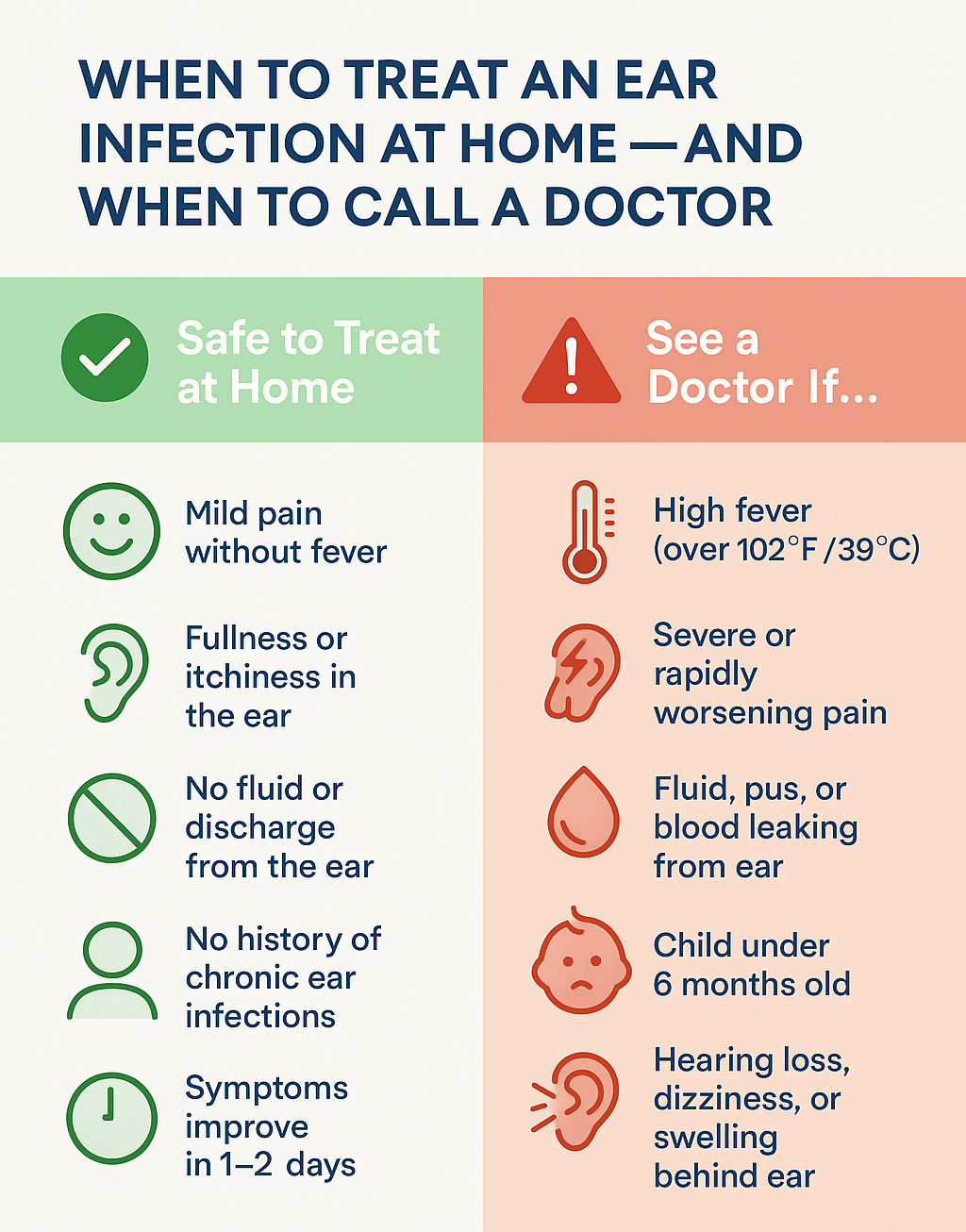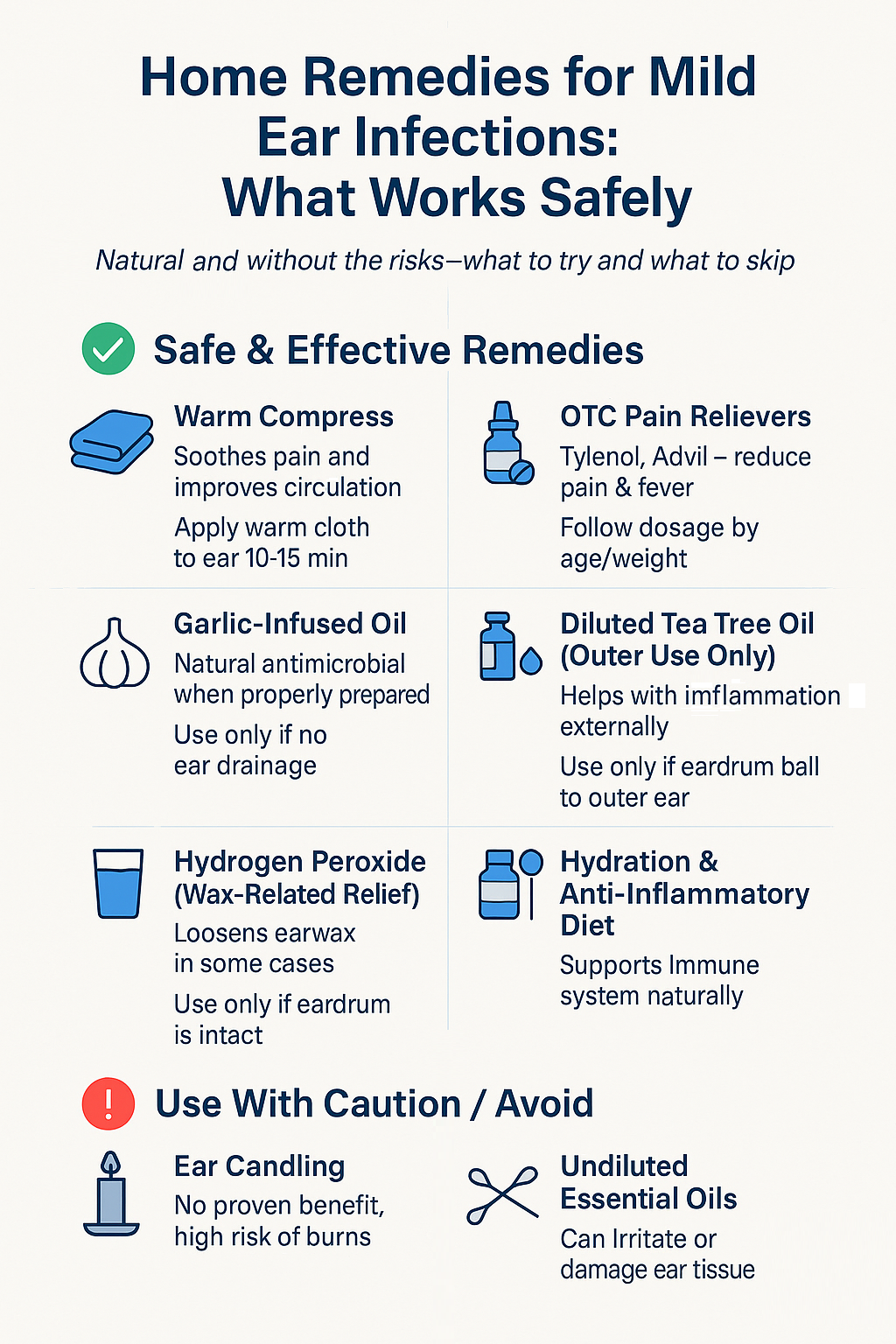An ear infection can come on quickly — and when it does, the pain, pressure, and discomfort can be tough to bear. While serious infections require medical attention, many mild to moderate cases can be treated effectively at home using safe, natural remedies and over-the-counter support.
But with so many online suggestions — from warm oils to garlic drops — it’s hard to know what actually works and what could do more harm than good. That’s why in this guide, we’ll separate fact from fiction and show you how to treat an ear infection at home safely. We’ll also explore the signs to watch for, what treatments are backed by evidence, and when it’s time to skip the DIY and call your doctor.
Whether you’re managing recurring infections, treating your child, or looking for immediate relief, this article gives you practical, trustworthy steps to handle ear infections from the comfort of home — and prevent them from coming back.
Understanding Ear Infections: What’s Really Going On?
Before reaching for a home remedy or over-the-counter pain reliever, it’s essential to understand what’s actually happening in the ear during an infection. Not all ear infections are the same, and knowing the type and severity can help you determine whether home treatment is appropriate or if medical attention is needed.
Causes and Types of Ear Infections
Most ear infections involve the middle ear, the space behind the eardrum. This area can fill with fluid when bacteria or viruses invade, often after a cold, sinus infection, or allergies. The Eustachian tube, which drains fluid from the ear to the throat, can get blocked — creating the perfect breeding ground for infection.
Common types of ear infections include:
| Type of Infection | Description |
|---|---|
| Acute Otitis Media (AOM) | Sudden, painful infection of the middle ear; often with fever and hearing changes. |
| Otitis Media with Effusion (OME) | Fluid remains in the ear after infection, usually without pain but may cause muffled hearing. |
| Swimmer’s Ear (Otitis Externa) | Infection of the ear canal, usually caused by trapped water; itchy, painful, and tender to touch. |
Ear infections are more common in children due to their smaller Eustachian tubes, but adults can also be affected — especially after colds, travel, or exposure to moisture.
When You Can Treat at Home vs. When to See a Doctor
Not every ear infection needs antibiotics or a trip to urgent care. Here’s a quick guide:
| Safe to Treat at Home If… | See a Doctor If… |
|---|---|
| Mild pain without fever | High fever (over 102°F / 39°C) |
| Ear feels full or itchy | Severe pain or rapid worsening symptoms |
| No fluid or discharge from the ear | Pus, fluid, or blood leaks from the ear |
| You or your child have no history of chronic ear infections | The person is under 6 months old or has a history of hearing issues |
Proven At-Home Treatments for Mild Ear Infections
When you or a loved one experiences the onset of a mild ear infection, especially with manageable pain and no fever, at-home care can offer real relief. These treatments help reduce inflammation, ease discomfort, and support the body’s natural healing — all without antibiotics.
Warm Compresses and Pain Relief
Applying gentle, consistent heat to the affected ear can be incredibly soothing. It helps:
Reduce pressure inside the ear
Improve circulation
Ease pain and tension in surrounding muscles
How to use:
Soak a clean washcloth in warm (not hot) water
Wring it out and place it over the infected ear for 10–15 minutes
Repeat as needed throughout the day
For children and adults alike, this simple remedy can be surprisingly effective.
Over-the-Counter Pain Relief
Medications like acetaminophen (Tylenol) or ibuprofen (Advil, Motrin) can:
Reduce earache pain
Lower mild fever
Ease body aches that may come with viral infections
Be sure to follow dosage instructions by age and weight, and consult a pediatrician for children under 2 years old.
Safe Use of Over-the-Counter Remedies
Some drugstores carry ear drops formulated for pain relief or for swimmer’s ear. These can contain ingredients like:
Benzocaine (a numbing agent)
Acetic acid (which helps dry out the ear canal)
Glycerin (for soothing irritation)
Always check the label:
Don’t use drops if the eardrum may be perforated (if fluid is leaking or pain is sharp).
Avoid in young children unless approved by a healthcare provider.
Use drops only as directed.
In many cases, these OTC options offer temporary symptom relief while the infection resolves naturally over a few days.

Natural and Holistic Ear Infection Remedies
Home remedies for ear infections have been used for centuries, especially in cultures that favor natural approaches over pharmaceuticals. While some natural methods are safe and soothing, others should be approached with caution. Here’s what works — and how to use it safely.
Garlic Oil, Tea Tree Oil, and Hydrogen Peroxide
Garlic Oil
Garlic is a powerful natural antimicrobial. Garlic-infused oil may help fight off mild bacterial infections and reduce inflammation.
How to use:
Warm a few drops of garlic-infused olive oil (available at health stores)
Test temperature to ensure it’s only slightly warm
Apply 2–3 drops into the affected ear and lie on the opposite side for 10 minutes
Caution: Do not use if the eardrum may be perforated or if there’s fluid discharge.
Tea Tree Oil
Tea tree oil is known for its antibacterial and anti-inflammatory properties, but it must always be diluted.
How to use:
Mix one drop of tea tree oil with a teaspoon of olive or coconut oil
Apply to a cotton ball, place gently in the outer ear (do not insert)
Leave for 10–15 minutes
Note: Direct drops of tea tree oil inside the ear canal can be irritating. Use only externally unless advised by a healthcare professional.
Hydrogen Peroxide
Hydrogen peroxide can help remove earwax and clean the outer ear — which might relieve pressure if the infection is mild.
How to use:
Place 2–3 drops of 3% hydrogen peroxide in the ear
Let it fizz for a few minutes, then drain by tilting your head
Warning: Do not use this method if there’s any suspicion of a ruptured eardrum or open wound.
Dietary and Immune Support Tips
Strengthening the immune system can help your body fight infections faster.
Stay hydrated: Water helps thin mucus and supports immune function.
Eat anti-inflammatory foods: Garlic, ginger, leafy greens, and berries help reduce inflammation.
Boost with supplements: Vitamin C, zinc, and probiotics may help if your diet lacks them.
Avoid sugar and processed foods, which can increase inflammation and weaken the immune response.
What to Avoid When Treating Ear Infections at Home
When ear pain strikes, it’s tempting to try anything that promises fast relief. But some well-meaning home remedies and online hacks can do more harm than good. Knowing what to avoid is just as important as knowing what helps.
Dangerous Myths and Harmful Practices
Here are some of the most common but risky treatments people try — and why you should steer clear:
| Unsafe Practice | Why It’s Harmful |
|---|---|
| Pouring undiluted essential oils into the ear | Can cause burns, irritation, or allergic reactions in the sensitive ear canal. |
| Using cotton swabs inside the ear | Pushes wax deeper, risks perforating the eardrum, and increases infection risk. |
| Candling (ear wax removal with fire) | No evidence of effectiveness; can burn the ear or cause wax to melt and harden. |
| Using alcohol or vinegar directly | Harsh solutions can dry out or inflame infected or sensitive tissue. |
| Ignoring symptoms for too long | Infections can spread to the mastoid bone or inner ear, leading to complications. |
Even natural ingredients can be dangerous if used improperly. The ear canal and eardrum are delicate — never insert or apply anything without knowing the condition of the eardrum.
Signs of Worsening Infection
Even with the best home care, not all infections resolve on their own. Here’s when it’s time to seek medical help immediately:
Severe or increasing pain
Fluid draining from the ear (especially pus or blood)
High fever (above 102°F / 39°C)
Swelling behind the ear or facial weakness
Dizziness, confusion, or hearing loss
These symptoms could indicate complications like mastoiditis, a ruptured eardrum, or a more serious middle/inner ear infection — all of which require professional treatment.

Preventing Future Infections Naturally
Once you’ve dealt with an ear infection, you’ll do anything to avoid another. Fortunately, there are simple, effective steps you can take to reduce your risk of recurring infections, especially if you’re prone to them or have children who are.
Hygiene, Ear Drying, and Nutrition
Keep Ears Dry and Clean
Water trapped in the ear — especially after swimming or showering — is a common cause of outer ear infections (like swimmer’s ear). Here’s how to prevent that:
Dry ears gently with a towel after swimming or bathing.
Tilt your head and tug the earlobe to drain trapped water.
Use alcohol-free drying ear drops if you swim frequently.
Avoid inserting anything into the ear canal, including cotton swabs. Instead, clean the outer ear only with a warm, damp cloth.
Boost Your Immune System
A strong immune system can fight off infections before they start. Focus on:
Eating a balanced, anti-inflammatory diet rich in fruits, vegetables, lean protein, and healthy fats
Getting adequate sleep (7–9 hours for adults, more for kids)
Staying physically active
Taking probiotics (either in food or supplements) to support gut and immune health
When to Get Regular Checkups
If you or your child has a history of:
Frequent ear infections
Allergies or sinus issues
Hearing changes
…then it’s wise to schedule routine hearing evaluations or ENT (ear, nose, throat) consultations.
For kids under 3, recurring infections may impact language development, so early detection and intervention are critical. For adults, unaddressed infections can lead to long-term hearing loss or balance issues.
Conclusion: Safe, Simple, and Smart Ear Infection Relief at Home
Ear infections can feel overwhelming — especially when they hit in the middle of the night or when a doctor isn’t immediately available. But with the right knowledge and care, many mild ear infections can be treated effectively at home, using a combination of natural remedies, over-the-counter support, and common sense prevention.
From warm compresses and garlic oil to hydration and immune support, the key is to act gently, stay observant, and know when to escalate care. Avoid risky or outdated treatments, and always watch for signs that suggest the infection is worsening.
Ultimately, treating an ear infection at home isn’t just about relief — it’s about preserving your hearing health, preventing complications, and taking proactive steps to reduce future risks.
When in doubt, trust your instincts and don’t hesitate to seek medical advice. The balance of home care and professional guidance is what keeps your ears — and your body — healthy, protected, and pain-free.
FAQs About Treating Ear Infections at Home
Can you treat an ear infection without antibiotics?
Yes, mild ear infections often resolve on their own. Warm compresses, OTC pain relievers, and natural remedies can ease symptoms while your body fights the infection.
What’s the best home remedy for ear infection pain?
A warm compress applied to the outer ear is one of the safest and most effective home treatments. OTC medications like ibuprofen or acetaminophen can also relieve pain and reduce inflammation.
Is it safe to put garlic or tea tree oil in the ear?
Yes, but only properly diluted oils and only if the eardrum is intact. Always test temperature and avoid use if there is discharge or severe pain.
When should I see a doctor for an ear infection?
Seek medical care if symptoms include high fever, fluid drainage, severe pain, or symptoms that worsen after 48 hours of home care.
Can children be treated at home for ear infections?
Mild cases in older children may be managed at home, but infants and toddlers should be seen by a pediatrician to avoid complications.
How can I prevent future ear infections naturally?
Keep ears dry, avoid smoking exposure, boost immune health with a nutritious diet, and monitor for early signs of infection to act quickly.
Disclaimer
This article is for informational purposes only and is not a substitute for professional medical advice, diagnosis, or treatment. If you are concerned about your hearing or ear health, please consult a qualified healthcare provider.






